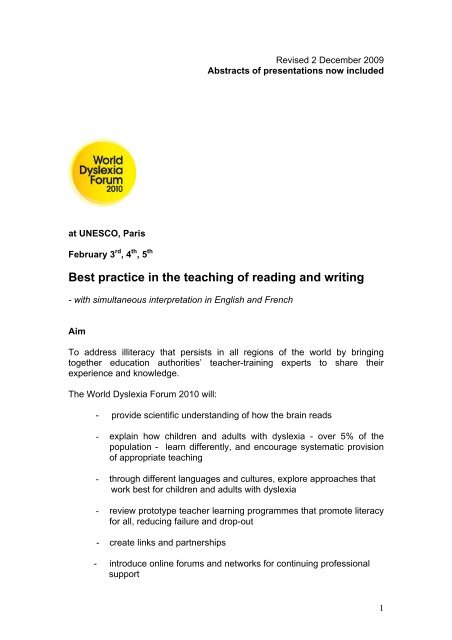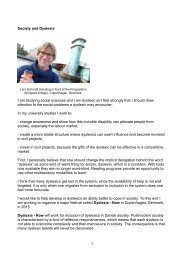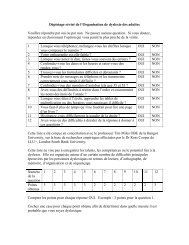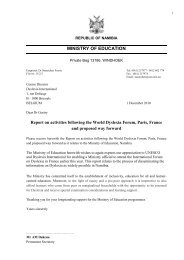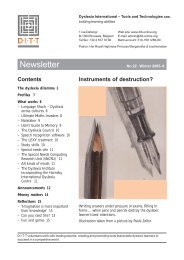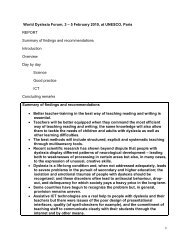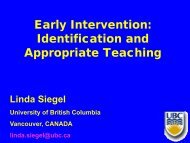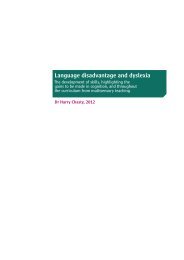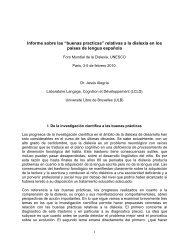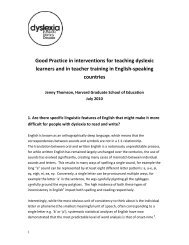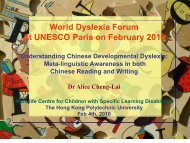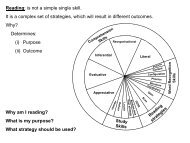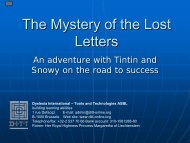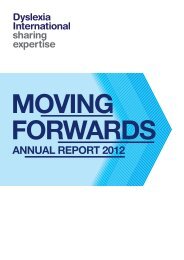Best practice in the teaching of reading and writing - Dyslexia ...
Best practice in the teaching of reading and writing - Dyslexia ...
Best practice in the teaching of reading and writing - Dyslexia ...
Create successful ePaper yourself
Turn your PDF publications into a flip-book with our unique Google optimized e-Paper software.
Revised 2 December 2009<br />
Abstracts <strong>of</strong> presentations now <strong>in</strong>cluded<br />
at UNESCO, Paris<br />
February 3 rd , 4 th , 5 th<br />
<strong>Best</strong> <strong>practice</strong> <strong>in</strong> <strong>the</strong> teach<strong>in</strong>g <strong>of</strong> read<strong>in</strong>g <strong>and</strong> writ<strong>in</strong>g<br />
- with simultaneous <strong>in</strong>terpretation <strong>in</strong> English <strong>and</strong> French<br />
Aim<br />
To address illiteracy that persists <strong>in</strong> all regions <strong>of</strong> <strong>the</strong> world by br<strong>in</strong>g<strong>in</strong>g<br />
toge<strong>the</strong>r education authorities’ teacher-tra<strong>in</strong><strong>in</strong>g experts to share <strong>the</strong>ir<br />
experience <strong>and</strong> knowledge.<br />
The World <strong>Dyslexia</strong> Forum 2010 will:<br />
- provide scientific underst<strong>and</strong><strong>in</strong>g <strong>of</strong> how <strong>the</strong> bra<strong>in</strong> reads<br />
- expla<strong>in</strong> how children <strong>and</strong> adults with dyslexia - over 5% <strong>of</strong> <strong>the</strong><br />
population - learn differently, <strong>and</strong> encourage systematic provision<br />
<strong>of</strong> appropriate teach<strong>in</strong>g<br />
- through different languages <strong>and</strong> cultures, explore approaches that<br />
work best for children <strong>and</strong> adults with dyslexia<br />
- review prototype teacher learn<strong>in</strong>g programmes that promote literacy<br />
for all, reduc<strong>in</strong>g failure <strong>and</strong> drop-out<br />
- create l<strong>in</strong>ks <strong>and</strong> partnerships<br />
- <strong>in</strong>troduce onl<strong>in</strong>e forums <strong>and</strong> networks for cont<strong>in</strong>u<strong>in</strong>g pr<strong>of</strong>essional<br />
support<br />
1
- establish a platform for a world-wide network <strong>of</strong> supportive forums.<br />
Prior to <strong>the</strong> Forum, education authorities will be <strong>in</strong>vited to endorse our<br />
manifesto at www.dyslexia-<strong>in</strong>ternational.org :<br />
‘We support free <strong>and</strong> fair education available for all, <strong>and</strong> equal opportunities<br />
for people who struggle with read<strong>in</strong>g <strong>and</strong> writ<strong>in</strong>g.’<br />
<strong>Dyslexia</strong> International’s pla<strong>in</strong> language description <strong>of</strong> dyslexia<br />
<strong>Dyslexia</strong> is a neurologically-based, life-long condition, which is <strong>of</strong>ten<br />
hereditary. It results <strong>in</strong> problems with:<br />
• read<strong>in</strong>g<br />
• writ<strong>in</strong>g<br />
• spell<strong>in</strong>g<br />
<strong>and</strong> is usually associated with difficulties <strong>in</strong>:<br />
• concentration<br />
• short-term memory<br />
• organization.<br />
<strong>Dyslexia</strong> is not <strong>the</strong> result <strong>of</strong> stupidity.<br />
It is not caused by:<br />
• poor school<strong>in</strong>g<br />
• poor home background<br />
• poor motivation for learn<strong>in</strong>g<br />
But poor visual <strong>and</strong> hear<strong>in</strong>g problems or poor muscle control<br />
can be associated.<br />
‘People with dyslexia have many talents that just do not happen to<br />
<strong>in</strong>clude read<strong>in</strong>g <strong>and</strong> writ<strong>in</strong>g.’<br />
John Ste<strong>in</strong>, Pr<strong>of</strong>essor <strong>of</strong> Physiology, University <strong>of</strong> Oxford, also Chair, <strong>Dyslexia</strong><br />
International’s Scientific Advisory Committee<br />
For formal <strong>and</strong> academic def<strong>in</strong>itions <strong>of</strong> dyslexia, see<br />
www.dyslexia-<strong>in</strong>ternational.org.<br />
Well-documented evidence shows learners with dyslexia will cope best with<br />
<strong>the</strong>ir difficulties if <strong>the</strong> nature <strong>of</strong> <strong>the</strong>ir dyslexia is understood early. This means<br />
that teachers will need tra<strong>in</strong><strong>in</strong>g as soon as possible <strong>in</strong> methods adapted to<br />
<strong>the</strong>se learners` needs.<br />
2
PROGRAMME<br />
3 FEBRUARY - DISCOVERY, THE SCIENCE<br />
08.00 REGISTRATION – TEA/COFFEE<br />
10.00 Welcome <strong>and</strong> open<strong>in</strong>g remarks by UNESCO Goodwill Ambassador,<br />
Her Royal Highness The Gr<strong>and</strong> Duchess Maria Teresa <strong>of</strong><br />
Luxembourg<br />
Chair: Pr<strong>of</strong>essor John Ste<strong>in</strong>, Pr<strong>of</strong>essor <strong>of</strong> Physiology, University <strong>of</strong> Oxford, UK<br />
(Pr<strong>of</strong>iles <strong>of</strong> all chairs <strong>and</strong> speakers, <strong>and</strong> abstracts <strong>of</strong> presentations are given at <strong>the</strong><br />
end <strong>of</strong> <strong>the</strong> programme.)<br />
10.30 Teach<strong>in</strong>g <strong>the</strong> bra<strong>in</strong> to read<br />
Dr Duncan Milne, Director for Literacy Tools, <strong>Dyslexia</strong> International,<br />
Brussels; Research Fellow, Centre for Cognitive Neuroscience <strong>of</strong> <strong>the</strong><br />
Mediterranean, CNRS, France<br />
11.15 The phonological deficit <strong>in</strong> developmental dyslexia<br />
Dr Franck Ramus, Laboratory <strong>of</strong> cognitive science <strong>and</strong><br />
psychol<strong>in</strong>gusitics, Department <strong>of</strong> Cognitive Studies, Ecole<br />
Normale Supérieure, Paris, France<br />
12.00 LUNCH<br />
Chair: Pr<strong>of</strong>essor L<strong>in</strong>da Siegel, Dorothy C. Lam Chair <strong>in</strong> Special Education at<br />
Yale, USA; University <strong>of</strong> British Columbia, Canada<br />
14.00 The bra<strong>in</strong> basis <strong>of</strong> read<strong>in</strong>g difficulties<br />
Pr<strong>of</strong>essor John Ste<strong>in</strong><br />
14.45 Hemispheric specialization <strong>and</strong> dyslexia<br />
Dr. Maria Luisa Lorusso, Neuropsychologist, Scientific Institute, E.<br />
Medea, Italy; Lecturer <strong>in</strong> Remediation <strong>of</strong> Developmental <strong>Dyslexia</strong>,<br />
University <strong>of</strong> Milan-Bicocca, Italy<br />
15.30 TEA/COFFEE BREAK<br />
16.00 Questions <strong>and</strong> answers<br />
Chair: John Ste<strong>in</strong>, Chair <strong>of</strong> <strong>Dyslexia</strong> International’s Scientific<br />
Advisory Committee<br />
3
17.30<br />
Taare Zameen Par<br />
(Little Stars on Earth)<br />
Reception, with extracts from <strong>the</strong> film presented by <strong>the</strong><br />
Creative Directors Amole Gupta <strong>and</strong> Deepa Bhatia with<br />
Kate Currawalla, President Maharashtra <strong>Dyslexia</strong><br />
Association<br />
4
4 FEBRUARY – GOOD PRACTICE<br />
Chair: Pr<strong>of</strong>essor Costas Porpodas, University <strong>of</strong> Patras, Greece<br />
09.00 Early <strong>in</strong>tervention: identification <strong>and</strong> appropriate teach<strong>in</strong>g<br />
Pr<strong>of</strong>essor L<strong>in</strong>da Siegel<br />
Survey <strong>of</strong> good <strong>practice</strong><br />
Feedback from <strong>the</strong> six language groups from five regions. Rapporteurs<br />
present <strong>the</strong>ir f<strong>in</strong>d<strong>in</strong>gs about teach<strong>in</strong>g <strong>and</strong> <strong>practice</strong> throughout <strong>the</strong> world <strong>in</strong> six<br />
languages. The reports will cover pre-specified topics.<br />
09.45 Arabic – Dr Sana Tibi, College <strong>of</strong> Education, United Arab<br />
Emirates University, United Arab Emirates<br />
10.15 Ch<strong>in</strong>ese – Pr<strong>of</strong>essor Alice Cheng-Lai, The Hong Kong<br />
Polytechnic University, Hong Kong, PRC<br />
10.45 TEA/COFFEE BREAK<br />
11.15 English – Pr<strong>of</strong>essor Jenny Thomson, Harvard Graduate School<br />
<strong>of</strong> Education, USA<br />
11.45 French – Pr<strong>of</strong>essor José Morais, Free University <strong>of</strong> Brussels,<br />
Belgium<br />
12.15 LUNCH<br />
14.00 Russian – Dr. Elena Grigorenko, Yale's Child Study Center,<br />
Department <strong>of</strong> Epidemiology <strong>and</strong> Public Health, <strong>and</strong> Department<br />
<strong>of</strong> Psychology, USA; Adjunct Pr<strong>of</strong>essor <strong>of</strong> Psychology at<br />
Columbia University, USA, <strong>and</strong> Moscow State University,<br />
Russian Federation<br />
14.30 Spanish – Dr Jésus Alegria, Free University <strong>of</strong> Brussels,<br />
Belgium<br />
Chair: Pr<strong>of</strong>essor Ludo Beheydt, Chair <strong>of</strong> Dutch L<strong>in</strong>guistics, Catholic University<br />
<strong>of</strong> Louva<strong>in</strong>, Belgium<br />
<strong>Dyslexia</strong> <strong>in</strong> different languages – Revisit<strong>in</strong>g <strong>the</strong> science<br />
15.00 <strong>Dyslexia</strong> <strong>in</strong> regular orthographies: re-balanc<strong>in</strong>g Anglo-centric research<br />
Pr<strong>of</strong>essor He<strong>in</strong>z Wimmer, Department <strong>of</strong> Psychology <strong>and</strong><br />
Center <strong>of</strong> Neurocognitive Research, University <strong>of</strong> Salzburg,<br />
Austria<br />
5
Education reform<br />
15.45 The F<strong>in</strong>nish system<br />
Claude Anttila, AMOPA-F<strong>in</strong>l<strong>and</strong><br />
16.30 Round-up <strong>of</strong> <strong>the</strong> day’s f<strong>in</strong>d<strong>in</strong>gs: essential elements <strong>of</strong> good<br />
teach<strong>in</strong>g <strong>practice</strong> to <strong>in</strong>sert <strong>in</strong>to teacher-tra<strong>in</strong><strong>in</strong>g<br />
programmes<br />
Dr Harry Chasty, Psychologist <strong>and</strong> <strong>in</strong>ternational consultant on<br />
learn<strong>in</strong>g abilities <strong>and</strong> disorders<br />
17.15 Ano<strong>the</strong>r chance to walk around <strong>the</strong> suppliers <strong>and</strong> see <strong>the</strong><br />
exhibition<br />
5 FEBRUARY – INFORMATION AND COMMUNICATIONS<br />
TECHNOLOGIES<br />
Chair: Andrew Law, former Head <strong>of</strong> BBC Worldwide Interactive<br />
Learn<strong>in</strong>g, current Director <strong>of</strong> Multi-Platform Broadcast<strong>in</strong>g for <strong>the</strong><br />
Open University, UK<br />
09.00 Us<strong>in</strong>g digital learn<strong>in</strong>g technologies to support special<br />
needs<br />
Diana Laurillard, Pr<strong>of</strong>essor <strong>of</strong> Learn<strong>in</strong>g with Digital<br />
Technologies, London Knowledge Lab, Institute <strong>of</strong> Education,<br />
UK; UNESCO Institute for Information Technologies <strong>in</strong><br />
Education, Moscow<br />
09.45 ‘Basics for teachers: <strong>Dyslexia</strong> – How to identify it <strong>and</strong> What<br />
to do’ – presentation <strong>of</strong> <strong>Dyslexia</strong> International’s Onl<strong>in</strong>e learn<strong>in</strong>g<br />
course<br />
10.15 TEA/COFFEE BREAK<br />
10.30 ‘<strong>Dyslexia</strong> – How to accompany <strong>and</strong> support people with<br />
read<strong>in</strong>g <strong>and</strong> writ<strong>in</strong>g difficulties’ – new film from <strong>Dyslexia</strong><br />
International demonstrat<strong>in</strong>g teach<strong>in</strong>g techniques <strong>in</strong> <strong>the</strong> <strong>in</strong>clusive<br />
classroom sett<strong>in</strong>g<br />
11.00 Free <strong>and</strong> accessible technologies support<strong>in</strong>g teachers <strong>and</strong><br />
tra<strong>in</strong>ers<br />
E.A. Draffan, Research Fellow, University <strong>of</strong> Southampton, UK;<br />
ICT education expert<br />
12.00 Conclud<strong>in</strong>g remarks - Presentations/awards to<br />
delegates, resolutions, <strong>and</strong> ways forward<br />
CLOSE<br />
6
In <strong>the</strong> exhibition area, 'Salle des Pas Perdus', beside <strong>the</strong><br />
Forum’s Salle ll:<br />
Suppliers <strong>of</strong> educational materials for people with dyslexia<br />
CECIAA, France; iansyst, UK; Micros<strong>of</strong>t School Technology Innovation<br />
Center, Belgium; Smart Kids, UK; White Space, UK<br />
Roll<strong>in</strong>g screen presentations:<br />
• <strong>Dyslexia</strong> Associations’ work world-wide – show<strong>in</strong>g support<br />
associations around <strong>the</strong> world<br />
• Free onl<strong>in</strong>e resources by <strong>Dyslexia</strong> International:<br />
- Language Shock – <strong>Dyslexia</strong> across cultures, a 28 m<strong>in</strong>ute<br />
awareness <strong>and</strong> tra<strong>in</strong><strong>in</strong>g film produced by <strong>the</strong> BBC,<br />
with guides <strong>in</strong> five languages<br />
- a do-it-yourself support group h<strong>and</strong>-book: <strong>Dyslexia</strong> Here <strong>and</strong><br />
There, with illustrations by Quent<strong>in</strong> Blake<br />
- onl<strong>in</strong>e conference reports by Pr<strong>of</strong>essors Stanislas Dehaene, José<br />
Morais <strong>and</strong> John Ste<strong>in</strong> on ‘<strong>Dyslexia</strong>: Neuroscience <strong>and</strong> cognitive<br />
psychology’<br />
Teach<strong>in</strong>g, learn<strong>in</strong>g <strong>and</strong> o<strong>the</strong>r resources<br />
Exhibition:<br />
- books, s<strong>of</strong>tware <strong>and</strong> hardware that support learn<strong>in</strong>g to read <strong>and</strong><br />
write <strong>in</strong> Arabic, Ch<strong>in</strong>ese, English, French, Russian <strong>and</strong> Spanish<br />
‘Creativity beyond words’<br />
- exhibition panels by architect Lord Richard Rogers, fashion <strong>and</strong><br />
furniture designers <strong>and</strong> o<strong>the</strong>rs, demonstrat<strong>in</strong>g outst<strong>and</strong><strong>in</strong>g<br />
achievements by people with dyslexia <strong>in</strong> all walks <strong>of</strong> life<br />
7
Pr<strong>of</strong>iles <strong>of</strong> speakers <strong>and</strong> chairpersons, <strong>and</strong> abstracts <strong>of</strong> presentations<br />
Alegria (Good <strong>practice</strong>, Spanish)<br />
Dr Jesus Alegria Iscoa is an Honorary Pr<strong>of</strong>essor at <strong>the</strong> Free University <strong>of</strong><br />
Brussels. He has spent his entire academic career <strong>in</strong> <strong>the</strong> laboratory for cognition<br />
<strong>and</strong> language development. His areas <strong>of</strong> <strong>in</strong>terest <strong>in</strong>clude literacy acquisition with<br />
a special emphasis on dyslexia, cross-l<strong>in</strong>guistic comparisons, <strong>and</strong> read<strong>in</strong>g<br />
acquisition <strong>in</strong> deaf persons. In collaboration with colleagues <strong>in</strong> both Belgium <strong>and</strong><br />
Spa<strong>in</strong> he has worked on sett<strong>in</strong>g up tools for evaluat<strong>in</strong>g phonological process<strong>in</strong>g <strong>and</strong> for <strong>the</strong><br />
basic mechanisms <strong>of</strong> read<strong>in</strong>g <strong>and</strong> spell<strong>in</strong>g.<br />
Abstract<br />
Scientific progress has shown that dyslexia is a biologically-grounded deficit affect<strong>in</strong>g phonological<br />
process<strong>in</strong>g which, at <strong>the</strong> behavioural level, results <strong>in</strong> poor read<strong>in</strong>g. The report will exam<strong>in</strong>e how ‘Good<br />
<strong>practice</strong>’ should be derived from <strong>the</strong>se f<strong>in</strong>d<strong>in</strong>gs.<br />
The first concerns <strong>the</strong> diffusion <strong>of</strong> well-established scientific <strong>in</strong>formation about <strong>the</strong> precise nature <strong>of</strong><br />
dyslexia, <strong>in</strong> all <strong>of</strong> <strong>the</strong> social contexts where it occurs. An important po<strong>in</strong>t to transmit is that <strong>the</strong> difficulties<br />
with written material for dyslexics are determ<strong>in</strong>ed nei<strong>the</strong>r by <strong>in</strong>tellectual nor motivational considerations.<br />
Here, <strong>the</strong> adequate tra<strong>in</strong><strong>in</strong>g <strong>of</strong> teachers must be a priority.<br />
The second po<strong>in</strong>t concerns <strong>the</strong> early identification <strong>of</strong> dyslexics. Psychol<strong>in</strong>guistic research has shown that<br />
preschoolers at risk have poor meta-phonological abilities as well as difficulties <strong>in</strong> tasks <strong>in</strong>volv<strong>in</strong>g<br />
manipulation <strong>of</strong> phonological representations such as picture nam<strong>in</strong>g, short-term-memory, f<strong>in</strong>e<br />
phonological discrim<strong>in</strong>ation, etc. This allows early detection <strong>of</strong> potential difficulties <strong>and</strong> <strong>in</strong>tervention before<br />
formal <strong>in</strong>struction <strong>in</strong> read<strong>in</strong>g beg<strong>in</strong>s.<br />
F<strong>in</strong>ally, <strong>the</strong> most adequate methods <strong>of</strong> teach<strong>in</strong>g <strong>and</strong> remediation will be exam<strong>in</strong>ed with special emphasis<br />
on <strong>the</strong> fact that <strong>the</strong> Spanish spell<strong>in</strong>g system is transparent: it represents words at <strong>the</strong> phonological level <strong>in</strong><br />
a fairly systematic manner. Phonic <strong>in</strong>struction is undoubtedly optimal for persons with dyslexia but also for<br />
normal children. Studies conducted <strong>in</strong> Spanish as well as <strong>in</strong> o<strong>the</strong>r alphabetic languages have shown that<br />
meta-phonological tra<strong>in</strong><strong>in</strong>g is an efficient tool for remediat<strong>in</strong>g dyslexia <strong>and</strong> also, when used before formal<br />
read<strong>in</strong>g <strong>in</strong>struction, can prevent troubles <strong>in</strong> read<strong>in</strong>g acquisition. Examples <strong>of</strong> <strong>the</strong>se activities will be<br />
exam<strong>in</strong>ed.<br />
Anttila (Good <strong>practice</strong>, F<strong>in</strong>l<strong>and</strong>)<br />
Claude Anttila is a qualified teacher <strong>in</strong> <strong>the</strong> French national system, now retired,<br />
hav<strong>in</strong>g taught for 36 years at all levels <strong>in</strong> <strong>the</strong> French Lycée, Hels<strong>in</strong>ki. Director <strong>of</strong><br />
French studies for four years, <strong>and</strong> expert <strong>in</strong> French <strong>in</strong> <strong>the</strong> department at national<br />
level for higher education from 1998 to 2005. Ms Anttila is a renowned expert<br />
<strong>and</strong> consultant <strong>in</strong> pr<strong>of</strong>essional development <strong>and</strong> exam<strong>in</strong>ations. She created a<br />
portal for French teachers <strong>in</strong> F<strong>in</strong>l<strong>and</strong>, promot<strong>in</strong>g higher visibility <strong>of</strong> French <strong>in</strong> <strong>the</strong><br />
Nordic countries, <strong>and</strong> also a site ‘Action for French’. Ms Anttila presents <strong>the</strong> F<strong>in</strong>nish school<br />
system <strong>in</strong> French-speak<strong>in</strong>g countries <strong>and</strong> is president <strong>of</strong> AMOPA-F<strong>in</strong>l<strong>and</strong> (decorated for<br />
services to education <strong>in</strong> French) <strong>and</strong> a representative for keep<strong>in</strong>g French alive <strong>in</strong> F<strong>in</strong>l<strong>and</strong>.<br />
Abstract - Why reform an educational system<br />
Confronted by unequal success rates <strong>in</strong> schools, F<strong>in</strong>l<strong>and</strong> reformed its system to give all<br />
children a good education <strong>in</strong> order to prepare <strong>the</strong>m for higher education. At <strong>the</strong> same time<br />
it upgraded <strong>the</strong> pr<strong>of</strong>essional st<strong>and</strong><strong>in</strong>g <strong>of</strong> teachers by improv<strong>in</strong>g <strong>the</strong> quality <strong>of</strong> <strong>the</strong>ir tra<strong>in</strong><strong>in</strong>g.<br />
These <strong>in</strong>itiatives to br<strong>in</strong>g more specialized knowledge to teachers were conceived <strong>in</strong><br />
order to enhance <strong>the</strong> prospects <strong>of</strong> young people.<br />
8
At <strong>the</strong> beg<strong>in</strong>n<strong>in</strong>g <strong>of</strong> 1980s nobody had been told about dyslexia. In fact its frequency is<br />
very significant (9.5 %) but this perception came about after better awareness amongst<br />
teachers <strong>of</strong> children with learn<strong>in</strong>g difficulties.<br />
Now <strong>the</strong> teacher has to teach each child <strong>in</strong> his or her class accord<strong>in</strong>g to <strong>the</strong> child’s needs<br />
us<strong>in</strong>g different techniques which also help all children. This requires a lot <strong>of</strong> preparation<br />
<strong>and</strong> know-how.<br />
The F<strong>in</strong>nish system does not make children repeat <strong>the</strong>ir year. It <strong>in</strong>tegrates children <strong>of</strong> different<br />
social classes with or without learn<strong>in</strong>g difficulties <strong>and</strong> encourages each child <strong>in</strong> <strong>the</strong> school to<br />
take an active part <strong>in</strong> life. By <strong>in</strong>clud<strong>in</strong>g children with difficulties, <strong>the</strong> reform has brought results<br />
which are not worse than elsewhere, as confirmed by <strong>the</strong> OECD’s research.<br />
Beheydt (Good <strong>practice</strong> – l<strong>in</strong>guistics), Chair<br />
language.<br />
Pr<strong>of</strong>essor Ludo Beheydt holds <strong>the</strong> chair <strong>of</strong> Dutch L<strong>in</strong>guistics at <strong>the</strong> Catholic<br />
University <strong>of</strong> Louva<strong>in</strong>, Belgium, <strong>and</strong> has studied cultural identity <strong>and</strong><br />
bil<strong>in</strong>gualism <strong>in</strong> depth. Whilst <strong>the</strong> value, <strong>and</strong> <strong>in</strong>deed necessity, <strong>of</strong> multil<strong>in</strong>gual<br />
abilities cannot be doubted, Pr<strong>of</strong>essor Beheydt f<strong>in</strong>ds that <strong>in</strong> some cases <strong>the</strong><br />
imposition <strong>of</strong> a second language, <strong>of</strong>ten <strong>in</strong> a very different cultural sett<strong>in</strong>g, can<br />
pose great difficulties for <strong>the</strong> child struggl<strong>in</strong>g to achieve competence <strong>in</strong> one<br />
Chasty (Educational psychology), Round-up <strong>of</strong> second day<br />
Dr Harry Chasty is a psychologist <strong>and</strong> <strong>in</strong>ternational consultant on learn<strong>in</strong>g<br />
abilities <strong>and</strong> disorders. He believes that <strong>the</strong>re is a matrix <strong>of</strong> learn<strong>in</strong>g difficulties<br />
underly<strong>in</strong>g dyslexia, affect<strong>in</strong>g auditory-phonological, visual <strong>and</strong> motor skills. He<br />
considers that <strong>the</strong> dyslexic’s retardations <strong>in</strong> literacy, numeracy <strong>and</strong> <strong>the</strong><br />
curriculum are attributable to <strong>the</strong> disparity between <strong>the</strong> student’s limited<br />
representational options <strong>and</strong> teachers’ <strong>of</strong>ten one-dimensional presentation <strong>of</strong> <strong>the</strong><br />
<strong>in</strong>formation to be learned. He advocates multi-sensory tra<strong>in</strong><strong>in</strong>g <strong>and</strong> challenges teachers, ‘If<br />
this child does not learn <strong>the</strong> way you teach, can you teach <strong>the</strong> way he learns to develop his<br />
skills’<br />
Cheng-Lai (Good <strong>practice</strong>, Ch<strong>in</strong>ese)<br />
Pr<strong>of</strong>essor Alice Cheng-Lai was educated at <strong>the</strong> Universities <strong>of</strong> Taiwan,<br />
Michigan <strong>and</strong> Hong Kong. She is <strong>the</strong> Associate Pr<strong>of</strong>essor <strong>in</strong> Educational<br />
Psychology at <strong>the</strong> Manulife Centre for Children with Specific Learn<strong>in</strong>g<br />
Disabilities at The Hong Kong Polytechnic University <strong>and</strong> Director <strong>of</strong> <strong>the</strong> Jo<strong>in</strong>t<br />
Centre for Child Development <strong>and</strong> Learn<strong>in</strong>g <strong>in</strong> Pek<strong>in</strong>g University, Beij<strong>in</strong>g. She<br />
has been conduct<strong>in</strong>g research <strong>in</strong>to children with developmental dyslexia <strong>and</strong><br />
specific learn<strong>in</strong>g disabilities for more than 15 years. This <strong>in</strong>cludes identification<br />
<strong>and</strong> <strong>in</strong>tervention <strong>of</strong> children consequently at risk for school failure <strong>and</strong> how <strong>the</strong> deficits are<br />
best addressed <strong>in</strong> Ch<strong>in</strong>ese-speak<strong>in</strong>g communities.<br />
Abstract<br />
Logistic regression analyses has revealed that Ch<strong>in</strong>ese readers with dyslexia were best<br />
dist<strong>in</strong>guished from age-matched controls with tasks <strong>of</strong> morphological awareness, speeded<br />
number nam<strong>in</strong>g, <strong>and</strong> vocabulary skill; performance on tasks <strong>of</strong> visual skills or phonological<br />
awareness failed to dist<strong>in</strong>guish <strong>the</strong> group. Path analyses fur<strong>the</strong>r revealed that a construct <strong>of</strong><br />
morphological awareness was <strong>the</strong> strongest consistent predictor <strong>of</strong> a variety <strong>of</strong> literacy-related<br />
skills across both groups. F<strong>in</strong>d<strong>in</strong>gs suggest that morphological awareness may be a core<br />
<strong>the</strong>oretical construct necessary for expla<strong>in</strong><strong>in</strong>g variability <strong>in</strong> read<strong>in</strong>g Ch<strong>in</strong>ese.<br />
9
The nature <strong>of</strong> <strong>the</strong> meta-l<strong>in</strong>guistic <strong>in</strong>sights that are important for read<strong>in</strong>g depends upon <strong>the</strong><br />
writ<strong>in</strong>g system. In an alphabetic writ<strong>in</strong>g system such as English, <strong>the</strong> crucial <strong>in</strong>sight beyond <strong>the</strong><br />
concept <strong>of</strong> a word is that letters represent phonemes. However, Ch<strong>in</strong>ese characters do not<br />
encode grapheme-to-phoneme correspondences, but <strong>in</strong>stead character-to-syllable <strong>and</strong><br />
character-to-morpheme correspondences. So, learn<strong>in</strong>g to read Ch<strong>in</strong>ese requires ra<strong>the</strong>r<br />
different <strong>in</strong>sights from young readers than does an alphabetic system.<br />
In <strong>the</strong> presentation, <strong>the</strong> reform <strong>of</strong> Ch<strong>in</strong>ese character <strong>in</strong>struction <strong>in</strong> Ch<strong>in</strong>ese schools will be<br />
briefly <strong>in</strong>troduced, <strong>the</strong> characteristics <strong>of</strong> Ch<strong>in</strong>ese orthography <strong>and</strong> Ch<strong>in</strong>ese orthographyphonology<br />
correspondence: regularity, consistency <strong>and</strong> a new method <strong>of</strong> character <strong>in</strong>struction<br />
termed morphological <strong>in</strong>struction will be expla<strong>in</strong>ed. Grounded <strong>in</strong> psychol<strong>in</strong>guistic research <strong>in</strong><br />
Ch<strong>in</strong>ese literacy, morphological <strong>in</strong>struction emphasizes knowledge <strong>of</strong> <strong>the</strong> <strong>in</strong>ternal structures <strong>of</strong><br />
<strong>the</strong> writ<strong>in</strong>g system. This method helps children with dyslexia to master <strong>the</strong> structural rules <strong>of</strong><br />
different types <strong>of</strong> characters <strong>and</strong> to apply rules analytically when learn<strong>in</strong>g to read <strong>and</strong> write<br />
new Ch<strong>in</strong>ese characters.<br />
Draffan (ICT solutions)<br />
E.A. Draffan tra<strong>in</strong>ed as a Speech <strong>and</strong> Language Therapist, before specialis<strong>in</strong>g <strong>in</strong><br />
<strong>the</strong> field <strong>of</strong> Assistive Technologies. She has s<strong>in</strong>ce worked with disabled students<br />
<strong>in</strong> Fur<strong>the</strong>r <strong>and</strong> Higher Education, set up an Assistive Technology Centre,<br />
contributed to <strong>the</strong> work <strong>of</strong> TechDis <strong>and</strong> o<strong>the</strong>r <strong>in</strong>stitutions <strong>and</strong> groups. She is now<br />
a Research Fellow at <strong>the</strong> University <strong>of</strong> Southampton with <strong>in</strong>terests <strong>in</strong> <strong>the</strong> ease <strong>of</strong><br />
use <strong>and</strong> accessibility <strong>of</strong> e-learn<strong>in</strong>g <strong>and</strong> has recently been work<strong>in</strong>g on <strong>the</strong> LexDis<br />
project funded by <strong>the</strong> Jo<strong>in</strong>t Information Systems Committee (UK).<br />
Abstract - Teacher <strong>and</strong> parent support forums – how to make <strong>the</strong>se work<br />
The presentation will explore <strong>the</strong> pros <strong>and</strong> cons <strong>of</strong> us<strong>in</strong>g technologies to collaborate with<br />
those support<strong>in</strong>g students with dyslexia: <strong>the</strong> excit<strong>in</strong>g nature <strong>of</strong> real time communication<br />
versus <strong>the</strong> issues <strong>of</strong> threaded forums <strong>and</strong> mail lists, <strong>the</strong> use <strong>of</strong> text to speech <strong>and</strong> text<strong>in</strong>g<br />
along with <strong>the</strong> importance <strong>of</strong> participation at all levels. A feel<strong>in</strong>g <strong>of</strong> <strong>in</strong>volvement <strong>and</strong> <strong>the</strong><br />
real help that can be provided results <strong>in</strong> positive outcomes as aga<strong>in</strong>st <strong>the</strong> trials <strong>of</strong> poor<br />
connections, costly devices, complex s<strong>of</strong>tware <strong>and</strong> time management.<br />
Forums that can be used at any time have been shown to be safe <strong>and</strong> ‘easy to use’<br />
environments by some researchers 1 . They can provide a more comfortable feel<strong>in</strong>g when<br />
personal issues are discussed <strong>and</strong> possibly act as an alternative to face-to-face groups 2 .<br />
The effectiveness <strong>of</strong> <strong>the</strong> emotional <strong>and</strong> <strong>in</strong>formational support that onl<strong>in</strong>e forums provide<br />
has been reported 3 . Confidentiality may be an issue but usually computer based onl<strong>in</strong>e<br />
forums require registration <strong>and</strong> passwords, so discussions can be kept away from <strong>the</strong><br />
public eye if required.<br />
It is hoped that delegates will leave with a clear underst<strong>and</strong><strong>in</strong>g <strong>of</strong> <strong>the</strong> types <strong>of</strong> free Web<br />
2.0 collaborative onl<strong>in</strong>e applications available <strong>and</strong> <strong>the</strong>ir accessibility. Individual <strong>and</strong> group<br />
chat <strong>and</strong> text messag<strong>in</strong>g, webcam / video systems as well as e-mail lists will be<br />
discussed <strong>and</strong> <strong>the</strong> use <strong>of</strong> mobile phone technologies for support networks.<br />
1. Anderson & Kanuka, 1997; Hsiung, 2000<br />
2. Kramish et al., 2001<br />
3. Hsiung, 2000<br />
10
Grigorenko (Good <strong>practice</strong>, Russian)<br />
Dr. Elena Grigorenko, Yale's Child Study Center, Department <strong>of</strong> Epidemiology<br />
<strong>and</strong> Public Health, <strong>and</strong> Department <strong>of</strong> Psychology, USA; Adjunct Pr<strong>of</strong>essor <strong>of</strong><br />
Psychology at Columbia University, USA, <strong>and</strong> Moscow State University, Russian<br />
Federation. Her current research <strong>in</strong>cludes studies <strong>of</strong> genes <strong>in</strong>volved <strong>in</strong> learn<strong>in</strong>g<br />
disabilities <strong>and</strong> cognitive process<strong>in</strong>g, with special emphasis on study<strong>in</strong>g m<strong>in</strong>ority<br />
samples. She has also studied genetic <strong>and</strong> environmental risk factors for<br />
behavioural problems.<br />
Abstract<br />
This presentation will provide a brief overview <strong>of</strong> <strong>the</strong> dom<strong>in</strong>ant methods <strong>of</strong> teach<strong>in</strong>g read<strong>in</strong>g <strong>in</strong><br />
Soviet <strong>and</strong> modern Russia. Dr Grigorenko will provide comparative analyses <strong>of</strong> <strong>the</strong>se<br />
methods, highlight<strong>in</strong>g both <strong>the</strong>ir differences <strong>and</strong> similarities <strong>and</strong> illustrate <strong>the</strong>se general<br />
comments with available data on <strong>the</strong> read<strong>in</strong>g performance <strong>of</strong> Russian children ‘<strong>the</strong>n’ <strong>and</strong><br />
‘now’. Given <strong>the</strong> l<strong>in</strong>guistic features <strong>of</strong> Russian, special attention will be given to considerations<br />
<strong>of</strong> accuracy <strong>and</strong> fluency <strong>and</strong> <strong>the</strong> comprehension <strong>of</strong> <strong>the</strong>se s<strong>in</strong>gle words along with <strong>the</strong><br />
connected text.<br />
Laurillard (ICT solutions)<br />
Diana Laurillard is Pr<strong>of</strong>essor <strong>of</strong> Learn<strong>in</strong>g with Digital Technologies at <strong>the</strong><br />
London Knowledge Lab, Institute <strong>of</strong> Education, lead<strong>in</strong>g research on a learn<strong>in</strong>g<br />
design support environment, <strong>and</strong> s<strong>of</strong>tware for dyscalculia. Previously she was<br />
Head <strong>of</strong> <strong>the</strong> e-Learn<strong>in</strong>g Strategy Unit, Department for Education <strong>and</strong> Skills, Pro-<br />
Vice-Chancellor for learn<strong>in</strong>g technologies <strong>and</strong> teach<strong>in</strong>g at <strong>the</strong> Open University,<br />
<strong>and</strong> on <strong>the</strong> Visit<strong>in</strong>g Committee on IT at Harvard University. Currently on <strong>the</strong><br />
Boards <strong>of</strong> <strong>the</strong> Observatory for Borderless HE, <strong>the</strong> UNESCO Institute for IT <strong>in</strong> Education<br />
(Moscow), <strong>the</strong> Centre for Applied Research <strong>in</strong> Educational Technologies (Cambridge), <strong>and</strong><br />
<strong>the</strong> Council for <strong>the</strong> FernUniversität (distance teach<strong>in</strong>g, The Hague), <strong>and</strong> external exam<strong>in</strong>er at<br />
<strong>the</strong> University <strong>of</strong> Oxford.<br />
Abstract - Us<strong>in</strong>g digital learn<strong>in</strong>g technologies to support special needs<br />
As digital technologies become more widespread <strong>in</strong> schools <strong>and</strong> communities, it is<br />
important to consider <strong>the</strong> advantages <strong>the</strong>y can br<strong>in</strong>g to SEN (special educational needs)<br />
teachers <strong>and</strong> <strong>the</strong>ir learners. There are different types <strong>of</strong> advantage, for learners, teachers,<br />
<strong>and</strong> parents, l<strong>in</strong>ked to different k<strong>in</strong>ds <strong>of</strong> technologies. Some exploit <strong>the</strong> onl<strong>in</strong>e<br />
communications aspect <strong>of</strong> <strong>the</strong> technology that can l<strong>in</strong>k parents <strong>in</strong>to <strong>the</strong> support<br />
programme; some use <strong>the</strong> <strong>in</strong>teractive quality <strong>of</strong> teach<strong>in</strong>g programs to motivate reluctant<br />
or struggl<strong>in</strong>g learners; some <strong>of</strong>fer a data-ga<strong>the</strong>r<strong>in</strong>g capability that can help <strong>the</strong> teacher<br />
track learner progress. Even very simple technologies can make a real difference to<br />
learners if <strong>the</strong>y are used well.<br />
The presentation will present some examples <strong>of</strong> technologies used <strong>in</strong> support <strong>of</strong> learners<br />
with special needs, with particular reference to dyslexia <strong>and</strong> dyscalculia (a lack <strong>of</strong><br />
‘number sense’ sometimes affect<strong>in</strong>g children who also have dyslexia).<br />
The develop<strong>in</strong>g new discipl<strong>in</strong>e <strong>of</strong> ‘educational neuroscience’ aims to f<strong>in</strong>d common ground<br />
<strong>in</strong> <strong>the</strong> research methodologies <strong>of</strong> neuroscience, cognitive psychology, <strong>and</strong> education, <strong>and</strong><br />
<strong>the</strong>reby <strong>in</strong>form both pedagogic <strong>practice</strong> <strong>and</strong> fur<strong>the</strong>r research. The Institute <strong>of</strong> Education<br />
has recently set up a Centre for Educational Neuroscience 1 <strong>in</strong> collaboration with<br />
University College <strong>and</strong> Birkbeck, at <strong>the</strong> University <strong>of</strong> London. One <strong>of</strong> <strong>the</strong> l<strong>in</strong>k<strong>in</strong>g<br />
mechanisms be<strong>in</strong>g explored is to embed current pedagogic <strong>practice</strong> <strong>in</strong> technology-based<br />
adaptive learn<strong>in</strong>g exercises, whose design is <strong>in</strong>formed also by <strong>the</strong> neuroscience f<strong>in</strong>d<strong>in</strong>gs.<br />
11
Both literacy <strong>and</strong> numeracy are potentially amenable to new ways <strong>of</strong> support<strong>in</strong>g learners,<br />
<strong>and</strong> an <strong>in</strong>troduction to this approach will be <strong>in</strong>cluded <strong>in</strong> <strong>the</strong> presentation.<br />
1. www.educationalneuroscience.org.uk<br />
Law (ICT solutions), Chair<br />
Andrew Law is <strong>the</strong> 'Director <strong>of</strong> Multi-Platform Broadcast<strong>in</strong>g' for The Open<br />
University, UK. He is responsible for co-ord<strong>in</strong>at<strong>in</strong>g <strong>the</strong> OU’s BBC, YouTube,<br />
iTunesU <strong>and</strong> o<strong>the</strong>r public Internet media strategy. Previously he worked for <strong>the</strong><br />
BBC for over 20 years as TV Producer, Director <strong>and</strong> Executive. He was<br />
also Head <strong>of</strong> BBC Worldwide Interactive Learn<strong>in</strong>g - a commercial e-learn<strong>in</strong>g<br />
company owned by <strong>the</strong> BBC, with clients <strong>in</strong>clud<strong>in</strong>g UNESCO, DFID (UK Department for<br />
International Development), The World Bank Institute, <strong>and</strong> National College <strong>of</strong> School<br />
Leadership. His <strong>in</strong>terest is <strong>in</strong> us<strong>in</strong>g Web 2.0 (second generation <strong>of</strong> web development <strong>and</strong><br />
design) <strong>and</strong> rich media to catalyse, engage <strong>and</strong> empower <strong>in</strong> order to transform learn<strong>in</strong>g<br />
experiences for all.<br />
Lorusso (Psychology)<br />
Dr. Maria Luisa Lorusso obta<strong>in</strong>ed her MA <strong>in</strong> Psychology at Padua University, <strong>and</strong><br />
MA <strong>in</strong> Cl<strong>in</strong>ical L<strong>in</strong>guistics, as well as her Ph.D, at <strong>the</strong> Royal University <strong>of</strong><br />
Gron<strong>in</strong>gen, The Ne<strong>the</strong>rl<strong>and</strong>s. She is now lead<strong>in</strong>g a cl<strong>in</strong>ical <strong>and</strong> research team <strong>in</strong><br />
<strong>the</strong> Scientific Institute for Diagnosis <strong>and</strong> Research <strong>in</strong> Childhood Pathologies, E.<br />
Medea, <strong>in</strong> Bosisio Par<strong>in</strong>i, Italy. Dr Lorusso coord<strong>in</strong>ates research projects on<br />
specific learn<strong>in</strong>g disabilities. With her group she has been runn<strong>in</strong>g studies<br />
compar<strong>in</strong>g different <strong>in</strong>tervention programmes <strong>and</strong> <strong>in</strong>vestigat<strong>in</strong>g <strong>the</strong> different<br />
neuropsychological <strong>and</strong> genetic factors <strong>in</strong>volved.<br />
Abstract - Hemispheric specialisation <strong>and</strong> dyslexia (with D.J. Bakker, Vrije University,<br />
Amsterdam)<br />
Accord<strong>in</strong>g to Bakker’s model <strong>of</strong> learn<strong>in</strong>g to read, <strong>in</strong>itial read<strong>in</strong>g is predom<strong>in</strong>antly mediated by<br />
<strong>the</strong> right cerebral hemisphere, while mature read<strong>in</strong>g should normally be under primary control<br />
<strong>of</strong> <strong>the</strong> left cerebral hemisphere. This reason<strong>in</strong>g fits <strong>in</strong> a historical l<strong>in</strong>e <strong>of</strong> <strong>the</strong>oriz<strong>in</strong>g that began<br />
with Orton <strong>and</strong> that recently was supported by <strong>the</strong> f<strong>in</strong>d<strong>in</strong>gs <strong>of</strong> several neuroimag<strong>in</strong>g <strong>and</strong><br />
psychophysiological studies. New data on <strong>the</strong> characteristics <strong>of</strong> subtypes <strong>of</strong> dyslexia identified<br />
accord<strong>in</strong>g to Bakker’s model will be presented.<br />
So-called hemisphere-specific stimulation (HSS) 1 thus aims at modify<strong>in</strong>g <strong>the</strong> degree <strong>of</strong><br />
<strong>in</strong>volvement <strong>of</strong> specific neuropsychological functions (ma<strong>in</strong>ly oppos<strong>in</strong>g l<strong>in</strong>guistic to visualspatial<br />
analysis) <strong>in</strong> <strong>the</strong> read<strong>in</strong>g process, both by selective stimulation <strong>of</strong> ei<strong>the</strong>r <strong>the</strong> left or right<br />
cerebral hemisphere through <strong>the</strong> (visual or tactile) sensory channels <strong>and</strong> by <strong>the</strong> <strong>in</strong>duction <strong>of</strong><br />
ei<strong>the</strong>r anticipatory or visually-based decipher<strong>in</strong>g strategies. Previous studies showed that<br />
attention, <strong>in</strong>hibition especially, process<strong>in</strong>g speed, <strong>and</strong> short-term memory play a role <strong>in</strong> <strong>the</strong><br />
effects <strong>of</strong> visual HSS 2 .<br />
Recent data from rehabilitation studies will be shown where underly<strong>in</strong>g mechanisms are<br />
<strong>in</strong>vestigated by vary<strong>in</strong>g <strong>the</strong> neuropsychological stimulation procedures <strong>in</strong> <strong>the</strong> treatment <strong>of</strong><br />
dyslexic children, sub-classified as P-types, L-types or M-types.<br />
It will be argued that <strong>in</strong>dividual characteristics such as <strong>the</strong> neuropsychological pr<strong>of</strong>ile <strong>and</strong><br />
dyslexia subtype are crucial factors <strong>in</strong> determ<strong>in</strong><strong>in</strong>g <strong>the</strong> outcomes <strong>of</strong> remediation programs.<br />
1. Bakker, 1990)<br />
2. Facoetti, Lorusso, Paganoni, Umiltà & Mascetti, 2003; Lorusso, Facoetti, & Molteni, 2004; Lorusso,<br />
Facoetti, Paganoni, Pezzani, & Molteni, 2006<br />
12
Milne (Neuroscience)<br />
Dr. Duncan Milne was educated at <strong>the</strong> Centre for Cognitive Neuroscience,<br />
University <strong>of</strong> Auckl<strong>and</strong>, New Zeal<strong>and</strong>. He is a research fellow at <strong>the</strong> Centre for<br />
<strong>the</strong> Cognitive Neuroscience <strong>of</strong> <strong>the</strong> Mediterranean, France, <strong>and</strong> chairs <strong>the</strong> British<br />
Special Needs Group, United K<strong>in</strong>gdom. His areas <strong>of</strong> <strong>in</strong>terest <strong>in</strong>clude read<strong>in</strong>g<br />
acquisition, <strong>the</strong>oretical models <strong>of</strong> read<strong>in</strong>g, cross-l<strong>in</strong>guistic studies <strong>of</strong> read<strong>in</strong>g <strong>and</strong><br />
dyslexia. He has also developed a number <strong>of</strong> educational resources for teach<strong>in</strong>g<br />
read<strong>in</strong>g <strong>and</strong> <strong>the</strong>se are used extensively throughout <strong>the</strong> world.<br />
Abstract - Teach<strong>in</strong>g <strong>the</strong> bra<strong>in</strong> to read<br />
In this session we will discuss <strong>the</strong> neural components <strong>of</strong> <strong>the</strong> read<strong>in</strong>g system <strong>and</strong> <strong>the</strong> neural<br />
circuitry beh<strong>in</strong>d read<strong>in</strong>g acquisition. The discussion will focus on how modules are connected<br />
toge<strong>the</strong>r to make a read<strong>in</strong>g system. Special emphasis will be given to teach<strong>in</strong>g methods <strong>and</strong><br />
<strong>the</strong> benefits <strong>of</strong> balanced literacy. F<strong>in</strong>ally, <strong>the</strong> ‘phonological model’ will be shown to describe<br />
poor read<strong>in</strong>g at <strong>the</strong> behavioural level, while a ‘neurological model’ is used to expla<strong>in</strong> <strong>the</strong><br />
various heterogeneous typologies observed cl<strong>in</strong>ically.<br />
Morais (Good <strong>practice</strong>, French)<br />
Pr<strong>of</strong>essor José Morais made his career at <strong>the</strong> Free University <strong>of</strong> Brussels, where<br />
he taught cognitive psychology, psychol<strong>in</strong>guistics <strong>and</strong> psychology <strong>of</strong> literacy. The<br />
cognitive consequences <strong>of</strong> literacy, read<strong>in</strong>g acquisition, <strong>and</strong> <strong>the</strong> mechanisms <strong>of</strong><br />
spoken word recognition are his ma<strong>in</strong> research topics. He is President <strong>of</strong> <strong>the</strong><br />
National Committee <strong>of</strong> Psychological Sciences <strong>of</strong> <strong>the</strong> Royal Academy <strong>of</strong> Belgium<br />
<strong>and</strong> was member <strong>of</strong> <strong>the</strong> Scientific Committee <strong>of</strong> <strong>the</strong> French ‘Observatoire national<br />
de la Lecture’ for 12 years.<br />
Abstract<br />
The report deals with <strong>the</strong> roots <strong>of</strong> dyslexia <strong>and</strong> <strong>the</strong> ma<strong>in</strong> trends <strong>of</strong> teach<strong>in</strong>g <strong>and</strong> <strong>of</strong> reeducation<br />
<strong>practice</strong> <strong>in</strong> French-speak<strong>in</strong>g countries.<br />
The stages <strong>of</strong> knowledge <strong>and</strong> process<strong>in</strong>g <strong>in</strong> learn<strong>in</strong>g to read that may lead to specific<br />
backwardness will be considered tak<strong>in</strong>g <strong>in</strong>to account <strong>the</strong> characteristics <strong>of</strong> <strong>the</strong> French<br />
orthographic code. The scientific literature on <strong>the</strong> read<strong>in</strong>g behaviour <strong>and</strong> abilities <strong>of</strong> Frenchspeak<strong>in</strong>g<br />
dyslexics will <strong>the</strong>n be briefly reviewed. The ma<strong>in</strong> recommendations that one may be<br />
allowed to <strong>in</strong>fer from present scientific knowledge on read<strong>in</strong>g <strong>and</strong> dyslexia concern<strong>in</strong>g good<br />
<strong>practice</strong> <strong>in</strong> teach<strong>in</strong>g <strong>and</strong> re-educat<strong>in</strong>g dyslexic children will be presented <strong>and</strong> justified. F<strong>in</strong>ally,<br />
an exploratory survey <strong>of</strong> <strong>the</strong> present state <strong>of</strong> beliefs <strong>and</strong> <strong>practice</strong>s – right or wrong – <strong>of</strong> <strong>the</strong><br />
people <strong>and</strong> <strong>in</strong>stitutions pr<strong>of</strong>essionally <strong>in</strong>volved with dyslexia <strong>in</strong> French-speak<strong>in</strong>g countries will<br />
be <strong>of</strong>fered, <strong>and</strong> <strong>the</strong>se <strong>practice</strong>s <strong>and</strong> beliefs will be confronted with <strong>the</strong> knowledge <strong>and</strong> <strong>the</strong><br />
recommendations presented earlier.<br />
Porpodas (Good <strong>practice</strong>), Chair<br />
Dr. Constant<strong>in</strong>os Porpodas is Pr<strong>of</strong>essor <strong>of</strong> Cognitive Psychology <strong>and</strong> Psychology<br />
<strong>of</strong> Read<strong>in</strong>g, at <strong>the</strong> Department <strong>of</strong> Education, University <strong>of</strong> Patras, Greece. He<br />
directs <strong>the</strong> Laboratory <strong>of</strong> Cognitive Analysis <strong>of</strong> Learn<strong>in</strong>g, Language <strong>and</strong> <strong>Dyslexia</strong>,<br />
<strong>and</strong> is scientific director <strong>of</strong> <strong>the</strong> Research <strong>and</strong> Diagnostic Unit <strong>of</strong> <strong>Dyslexia</strong>, Read<strong>in</strong>g<br />
<strong>and</strong> Spell<strong>in</strong>g <strong>of</strong> his university. He helped develop <strong>the</strong> academic subjects <strong>of</strong><br />
Cognitive Psychology, Psychology <strong>of</strong> Read<strong>in</strong>g <strong>and</strong> Cognitive Analysis <strong>of</strong> <strong>Dyslexia</strong> <strong>in</strong> Greek<br />
universities. His ma<strong>in</strong> research <strong>in</strong>terests <strong>in</strong>clude <strong>the</strong> analysis <strong>of</strong> cognitive processes <strong>in</strong>volved<br />
<strong>in</strong> read<strong>in</strong>g <strong>and</strong> spell<strong>in</strong>g <strong>of</strong> dyslexic <strong>and</strong> normal readers <strong>in</strong> Greek, <strong>the</strong> development <strong>of</strong> read<strong>in</strong>g<br />
<strong>and</strong> spell<strong>in</strong>g <strong>in</strong> normal <strong>and</strong> dyslexic children, <strong>and</strong> language (oral <strong>and</strong> written) comprehension<br />
by normal, dyslexic <strong>and</strong> learn<strong>in</strong>g disabled children.<br />
13
Ramus (Cognitive science)<br />
Dr Franck Ramus graduated from <strong>the</strong> Ecole Polytechnique <strong>and</strong> obta<strong>in</strong>ed a PhD <strong>in</strong><br />
Cognitive Science from <strong>the</strong> Ecole des Hautes Etudes en Sciences Sociales <strong>in</strong><br />
Paris. He is now a CNRS research scientist at <strong>the</strong> Ecole Normale Supérieure,<br />
where he studies language acquisition, its disorders (dyslexia, specific language<br />
impairment, autism). In 2004 he received <strong>the</strong> Norman Geschw<strong>in</strong>d - Rod<strong>in</strong> Prize for<br />
his post-doctoral research on dyslexia. At <strong>the</strong> national policy level, he participated <strong>in</strong> <strong>the</strong><br />
INSERM 2007 expert report on <strong>Dyslexia</strong>, dysorthography, dyscalculia. He is also a member <strong>of</strong><br />
<strong>the</strong> scientific committee <strong>of</strong> <strong>the</strong> Fédération Française des Dys, which federates most <strong>of</strong> <strong>the</strong><br />
French associations concerned with learn<strong>in</strong>g disabilities.<br />
Abstract - The phonological deficit <strong>in</strong> developmental dyslexia<br />
The majority <strong>of</strong> children with developmental dyslexia present with a ‘phonological deficit’. I<br />
will expla<strong>in</strong> <strong>the</strong> different dimensions <strong>of</strong> <strong>the</strong> phonological deficit, review <strong>the</strong> evidence<br />
show<strong>in</strong>g that dyslexic children have difficulties <strong>in</strong> <strong>the</strong>se areas, as well as <strong>the</strong> evidence<br />
establish<strong>in</strong>g <strong>the</strong> l<strong>in</strong>k between <strong>the</strong> phonological deficit <strong>and</strong> read<strong>in</strong>g disability.<br />
Siegel (Psychology)<br />
Pr<strong>of</strong>essor L<strong>in</strong>da Siegel was educated at Queens College <strong>of</strong> <strong>the</strong> City University <strong>of</strong><br />
New York <strong>and</strong> Yale University, USA. She holds <strong>the</strong> Dorothy C. Lam Chair <strong>in</strong><br />
Special Education at Yale <strong>and</strong> also works at <strong>the</strong> University <strong>of</strong> British Columbia,<br />
Canada. Her areas <strong>of</strong> <strong>in</strong>terest <strong>in</strong>clude identification <strong>of</strong> children at risk for school<br />
failure <strong>and</strong> dyslexia, one study <strong>of</strong> which was realized through a longitud<strong>in</strong>al<br />
survey <strong>in</strong> North Vancouver. She has also studied cognitive aspects <strong>of</strong> learn<strong>in</strong>g<br />
disabilities, <strong>and</strong> bil<strong>in</strong>gual <strong>and</strong> multicultural education.<br />
Synopsis - Early identification <strong>and</strong> <strong>in</strong>tervention to prevent read<strong>in</strong>g failure<br />
Early identification <strong>and</strong> <strong>in</strong>tervention programs can prevent read<strong>in</strong>g failure <strong>and</strong> reduce <strong>the</strong><br />
<strong>in</strong>cidence <strong>and</strong> severity <strong>of</strong> dyslexia. The results <strong>of</strong> a 8-year longitud<strong>in</strong>al study with<br />
approximately 950 children have shown that children at risk for read<strong>in</strong>g difficulties can be<br />
detected at school entry <strong>and</strong>, if appropriate <strong>in</strong>tervention is provided, most read<strong>in</strong>g failure<br />
can be prevented.<br />
Children <strong>in</strong> Canada enter school at age 5. In one school district all <strong>of</strong> <strong>the</strong> children were<br />
screened dur<strong>in</strong>g <strong>the</strong> first few months <strong>of</strong> school entry. A simple screen<strong>in</strong>g system, last<strong>in</strong>g<br />
15-20 m<strong>in</strong>utes <strong>and</strong> <strong>in</strong>dividually adm<strong>in</strong>istered by teachers or o<strong>the</strong>r school personnel was<br />
used. The results showed that 25% <strong>of</strong> <strong>the</strong> children with English as a first language (L1)<br />
<strong>and</strong> 51% <strong>of</strong> children with English as a second language (ESL) were detected as be<strong>in</strong>g at<br />
risk for read<strong>in</strong>g difficulties.<br />
The screen<strong>in</strong>g <strong>in</strong> k<strong>in</strong>dergarten consisted <strong>of</strong> tasks assess<strong>in</strong>g phonological awareness,<br />
letter nam<strong>in</strong>g, syntactic awareness, <strong>and</strong> memory for language. The <strong>in</strong>tervention <strong>in</strong><br />
k<strong>in</strong>dergarten <strong>and</strong> grade 1 consisted <strong>of</strong> a classroom based program called Firm<br />
Foundations that stressed vocabulary, phonological awareness, <strong>and</strong> phonics. A read<strong>in</strong>g<br />
comprehension tra<strong>in</strong><strong>in</strong>g program, called Read<strong>in</strong>g 44, was used <strong>in</strong> grade 2 <strong>and</strong> <strong>the</strong> later<br />
grades. In grade 7, at age 13, 1.5 % <strong>of</strong> <strong>the</strong> L1 children <strong>and</strong> 2.1% <strong>of</strong> <strong>the</strong> ESL children were<br />
dyslexic. These rates are significantly lower than what is found <strong>in</strong> most jurisdictions.<br />
Children at risk for read<strong>in</strong>g difficulties can be detected at school entry <strong>and</strong>, if appropriate<br />
remediation is provided, most read<strong>in</strong>g failure can be prevented. The program was equally<br />
successful with L1 <strong>and</strong> ESL children. Appropriate early identification <strong>and</strong> <strong>in</strong>tervention can<br />
prevent most read<strong>in</strong>g failure.<br />
14
Ste<strong>in</strong> (Neuroscience)<br />
Pr<strong>of</strong>essor John F. Ste<strong>in</strong>, Fellow <strong>of</strong> <strong>the</strong> Royal College <strong>of</strong> Physicians, was educated<br />
at Oxford University, UK, <strong>and</strong> St Thomas’ Hospital, London. Currently he is<br />
Pr<strong>of</strong>essor <strong>of</strong> Physiology at Oxford. His research papers encompass numerous<br />
aspects <strong>of</strong> neuroscience, <strong>in</strong>clud<strong>in</strong>g anatomy, neurodevelopment, motor function,<br />
pa<strong>in</strong>, genetics <strong>and</strong> metabolism. He is particularly <strong>in</strong>terested <strong>in</strong> magnocellular<br />
deficit with<strong>in</strong> <strong>the</strong> visual pathway, <strong>and</strong> is actively <strong>in</strong>volved with organizations for<br />
dyslexics <strong>and</strong> associated research. Pr<strong>of</strong>essor Ste<strong>in</strong> is <strong>the</strong> Chairman <strong>of</strong> <strong>Dyslexia</strong><br />
International’s Scientific adisory Committee.<br />
Synopsis - Wobbles, warbles & fish: <strong>the</strong> bra<strong>in</strong> basis <strong>of</strong> dyslexia<br />
Of <strong>the</strong> 10 % <strong>of</strong> children who f<strong>in</strong>d it unexpectedly difficult to learn to read fluently, despite<br />
normal <strong>in</strong>telligence, health <strong>and</strong> education (developmental dyslexia), <strong>the</strong> majority suffer<br />
from visual problems. They compla<strong>in</strong> that letters appear to move around, change places,<br />
blur <strong>and</strong> glare when <strong>the</strong>y try to read. It is probable that <strong>the</strong>se problems are caused by<br />
impaired development <strong>of</strong> ‘magnocellular’ nerve cells <strong>in</strong> <strong>the</strong> visual system. This new<br />
underst<strong>and</strong><strong>in</strong>g <strong>of</strong> <strong>the</strong> visual problems has enabled <strong>the</strong> development <strong>of</strong> highly effective<br />
treatments, such as yellow or blue coloured filters, eye patch<strong>in</strong>g <strong>and</strong> vergence exercises.<br />
O<strong>the</strong>r dyslexics experience auditory problems which impair <strong>the</strong>ir ability to sequence word<br />
sounds or rapidly to translate letters <strong>in</strong>to <strong>the</strong>ir sounds. These are probably due to<br />
impaired development <strong>of</strong> auditory magnocells <strong>and</strong> <strong>the</strong>se weaknesses can <strong>of</strong>ten be<br />
alleviated by auditory tra<strong>in</strong><strong>in</strong>g. Thus impaired development <strong>of</strong> magnocells lies at <strong>the</strong> heart<br />
<strong>of</strong> dyslexia. This is partly genetic, partly associated with autoimmunity <strong>and</strong> partly<br />
nutritional. I shall <strong>the</strong>refore briefly describe some genes that we have identified, <strong>the</strong><br />
possible role <strong>of</strong> maternal antibodies <strong>and</strong> <strong>the</strong> benefits <strong>of</strong> fish oils.<br />
Thomson (Good <strong>practice</strong>, English)<br />
Dr. Jenny Thomson, Certificate <strong>of</strong> Cl<strong>in</strong>ical Competence <strong>in</strong> Speech-Language<br />
Pathology (CCC-SLP), is Assistant Pr<strong>of</strong>essor <strong>of</strong> Education at <strong>the</strong> Harvard<br />
Graduate School <strong>of</strong> Education, USA. Her research focuses upon <strong>the</strong><br />
developmental pre-cursors <strong>of</strong> read<strong>in</strong>g difficulties. Follow<strong>in</strong>g tra<strong>in</strong><strong>in</strong>g <strong>and</strong><br />
experience work<strong>in</strong>g as a Speech <strong>and</strong> Language Pathologist, her doctoral research<br />
was <strong>the</strong> first study to f<strong>in</strong>d highly significant relationships between children’s auditory rise-time<br />
sensitivity <strong>and</strong> <strong>the</strong>ir phonological <strong>and</strong> literacy skills (Goswami et al., 2002; Thomson &<br />
Goswami, <strong>in</strong> press). Her current research cont<strong>in</strong>ues to explore <strong>the</strong> role <strong>of</strong> rhythm sensitivity <strong>in</strong><br />
both <strong>the</strong> identification <strong>and</strong> remediation <strong>of</strong> read<strong>in</strong>g difficulties us<strong>in</strong>g behavioural <strong>and</strong> neural<br />
measures.<br />
Abstract<br />
This report will summarize best <strong>practice</strong> for dyslexia across countries where English is <strong>the</strong><br />
primary language <strong>of</strong> <strong>in</strong>struction. Three key elements emerge from questionnaire<br />
responses as be<strong>in</strong>g critical to ensur<strong>in</strong>g <strong>the</strong> academic, vocational <strong>and</strong> socio-emotional<br />
success for <strong>in</strong>dividuals with dyslexia.<br />
The first element <strong>of</strong> best <strong>practice</strong> is accurate <strong>and</strong> timely identification <strong>of</strong> students who<br />
are at risk <strong>of</strong>, or already manifest<strong>in</strong>g difficulties with read<strong>in</strong>g. Characteriz<strong>in</strong>g <strong>the</strong><br />
‘unexpected’ nature <strong>of</strong> read<strong>in</strong>g difficulties <strong>in</strong> dyslexia is a complex task <strong>and</strong> a number <strong>of</strong><br />
current solutions are presented.<br />
The second element <strong>of</strong> best <strong>practice</strong> is teacher tra<strong>in</strong><strong>in</strong>g <strong>and</strong> <strong>the</strong> importance <strong>of</strong> ensur<strong>in</strong>g<br />
both a basic level <strong>of</strong> dyslexia awareness among classroom teachers, as well as<br />
accessible support from specialists with more advanced knowledge.<br />
The f<strong>in</strong>al element is <strong>the</strong> optimal nature <strong>of</strong> <strong>in</strong>struction for <strong>in</strong>dividuals with dyslexia. The<br />
importance <strong>of</strong> <strong>in</strong>tensive <strong>and</strong> systematic phonics, especially <strong>in</strong> <strong>the</strong> early years is<br />
15
emphasized. Emerg<strong>in</strong>g <strong>in</strong>sights on best <strong>practice</strong> for older students with dyslexia are also<br />
exam<strong>in</strong>ed, as well as broader <strong>in</strong>structional pr<strong>in</strong>ciples to develop organization skills,<br />
positive self-esteem <strong>and</strong> <strong>the</strong> range <strong>of</strong> competencies needed for <strong>the</strong> fullest realization <strong>of</strong><br />
an <strong>in</strong>dividual’s potential.<br />
Tibi (Good <strong>practice</strong>, Arabic)<br />
Dr. Sana Tibi is an Associate pr<strong>of</strong>essor at <strong>the</strong> department <strong>of</strong> Special Education at<br />
<strong>the</strong> United Arab Emirates University, with a doctorate <strong>in</strong> Communication Sciences<br />
<strong>and</strong> Disorders from <strong>the</strong> University <strong>of</strong> Florida, USA. She is a consultant to <strong>the</strong> World<br />
Bank <strong>and</strong> UNESCO on Arabic read<strong>in</strong>g assessment, dyslexia <strong>and</strong> o<strong>the</strong>r learn<strong>in</strong>g<br />
difficulties. She has given several presentations <strong>in</strong> <strong>in</strong>ternational <strong>and</strong> regional<br />
conferences <strong>and</strong> workshops on issues perta<strong>in</strong><strong>in</strong>g to children’s literacy. Dr. Tibi has published<br />
several articles <strong>in</strong> <strong>in</strong>ternational <strong>and</strong> regional journals, served as a reviewer for some<br />
<strong>in</strong>ternational scientific journals <strong>and</strong> panels <strong>and</strong> written two books on read<strong>in</strong>g difficulties. She is<br />
also <strong>in</strong>terested <strong>in</strong> issues related to children’s speech <strong>and</strong> language disorders, language<br />
acquisition, <strong>and</strong> literacy development.<br />
Abstract<br />
This report will summarize different <strong>practice</strong>s for teach<strong>in</strong>g people with dyslexia across<br />
different Arabic-speak<strong>in</strong>g countries. Eight <strong>of</strong> <strong>the</strong> n<strong>in</strong>eteen Arabic-speak<strong>in</strong>g countries<br />
responded to <strong>the</strong> ‘Good <strong>practice</strong>’ questionnaire which <strong>Dyslexia</strong> International diffused on its<br />
web site. The presentation will cover common issues raised by respondents such as<br />
language constra<strong>in</strong>ts <strong>and</strong> challenges that are considered as barriers to good <strong>practice</strong> <strong>in</strong><br />
deal<strong>in</strong>g with dyslexia. The report will highlight <strong>the</strong> issues that need immediate attention <strong>in</strong> <strong>the</strong><br />
hope <strong>of</strong> provid<strong>in</strong>g some form <strong>of</strong> <strong>in</strong>tervention. Examples <strong>of</strong> <strong>the</strong>se issues are: lack <strong>of</strong><br />
st<strong>and</strong>ardised assessment tools <strong>in</strong> Arabic, as well as materials for <strong>in</strong>tervention <strong>and</strong><br />
methodologies that help <strong>the</strong> Arabic-speak<strong>in</strong>g <strong>in</strong>dividual with dyslexia.<br />
Wimmer (Psychology)<br />
Pr<strong>of</strong>essor He<strong>in</strong>z Josef Wimmer was educated at <strong>the</strong> University <strong>of</strong> Salzburg,<br />
Austria <strong>and</strong> <strong>the</strong> University <strong>of</strong> M<strong>in</strong>nesota, USA. He heads <strong>the</strong> Developmental<br />
Psychology Work<strong>in</strong>g Group at <strong>the</strong> Department <strong>of</strong> Psychology <strong>and</strong> Center <strong>of</strong><br />
Neurocognitive Research, Salzburg. He has <strong>in</strong>vestigated <strong>the</strong> manifestation <strong>of</strong><br />
dyslexia <strong>in</strong> different orthographies <strong>and</strong> underly<strong>in</strong>g visual <strong>and</strong> verbal impairments.<br />
Recently Pr<strong>of</strong>essor Wimmer`s group has <strong>in</strong>vestigated functional <strong>and</strong> structural bra<strong>in</strong><br />
abnormalities related to dyslexia.<br />
Abstract<br />
My talk will provide an overview <strong>of</strong> our neurocognitive research <strong>and</strong> will be set <strong>in</strong> a<br />
cultural context, that is a ra<strong>the</strong>r regular German orthography <strong>and</strong> a syn<strong>the</strong>tic phonics<br />
teach<strong>in</strong>g approach. Topics will be: a) manifestation <strong>of</strong> <strong>the</strong> disorder (eye movement data);<br />
b) associated (<strong>and</strong> non-associated) perceptual <strong>and</strong> cognitive impairments; <strong>and</strong> c)<br />
functional neuro-anatomical bra<strong>in</strong> abnormalities. The differences to largely English-based<br />
dyslexia research will be highlighted.<br />
16


